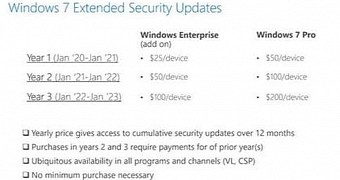Windows 7 is projected to reach the end of support in January 2020, and customers who want to receive updates at no additional cost must upgrade to Windows 8.1 or Windows 10 before this deadline.
On the other hand, devices that will still run Windows 7 next year will be provided with two options: remain unpatched and thus face the risks of potential exploits and pay for custom support that Microsoft will offer under its Extended Security Updates (ESU) program.
Needless to say, updates won’t come cheap, and according to estimated prices offered by Microsoft to a number of partners, and obtained by ZDNet, customers will have to pay $50 per Windows 7 device in the first year after the end of support is reached.
Beginning with the second year, the price doubles, so updates for just one device will cost $100, while another 100 percent price increase takes place in the third year when Microsoft will charge $200 per device.
More affordable patches for Windows 7 Enterprise
In the case of Windows 7 Enterprise, all these prices are 50% off, so customers have to pay $25, $50, and $100 per device in the first, second, and third year, respectively.
Basically, the whole idea behind this effort is to provide customers with continued Windows 7 support until they upgrade to a newer Windows version, and it’s estimated that everyone should be able to complete the migration in three years.
Government agencies and organizations across the world are the most likely to purchase custom Windows 7 support, at least for the first year, as upgrading to a newer version of the operating system is a more complex process due to app compatibility concerns.
Microsoft, however, says app compatibility shouldn’t be an issue, as the 99 percent of the software running on Windows 7 should also work flawlessly on Windows 10 too.

 14 DAY TRIAL //
14 DAY TRIAL //